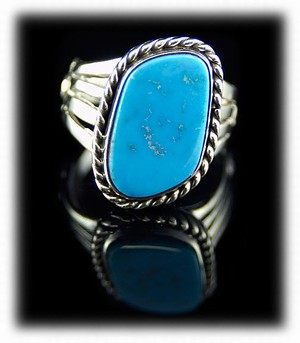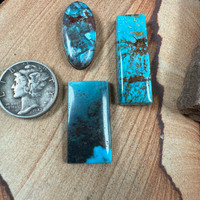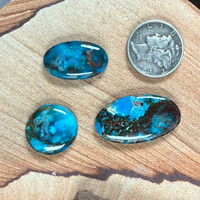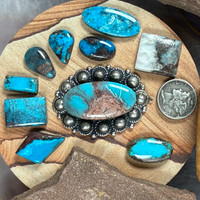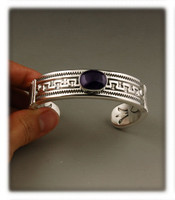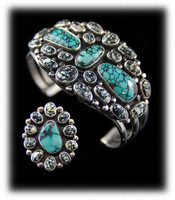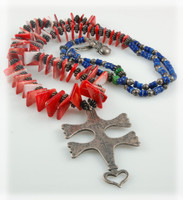 Loading... Please wait...
Loading... Please wait...- 970-759-1040 Text / Voice
- Gift Certificates
- My Account
Currency Displayed in
- Home
- Turquoise Learning Center
- Turquoise Mines List
- American Turquoise
- Blue Gem Turquoise
Categories
Blue Gem Turquoise
Blue Gem Turquoise
The Blue Gem Turquoise Story
Blue Gem Turquoise was actually more than one mine. There have been several Blue Gem Turquoise claims throughout history. There was the Tonopah Blue Gem or "Royal Blue" Tiffany Claims, The Mina Blue Gem Claims, and the most famous being the Battle Mtn. Blue Gem mine.
Tonopah Blue Gem Turquoise
Royston is a district in Nevada consisting of three turquoise mines: Bunker Hill Turquoise Mine, Oscar Wehrend Turquoise Mine, and the main producer, Royal Blue Turquoise Mine. The Royal Blue Turquoise Mine was owned and operated for number of years by the Tiffany Company at which it was calle Royal Blue or Tonopah Blue Gem Turquoise. The Royal Blue claims produced some of the most beautiful turquoise to ever hit the market. Tiffany was mainly after the blue turquoise that the Royal Blue Turquoise Mine Produced. At one time Tiffany Company produced tons of Blue Gem Turquoise Jewelry with high grade American Turquoise. The plain blue, the blue with golden yellow//brown web, and water web stones were the most desirable at that time. Royston is now known for its beautiful colors ranging from deep green to rich, light blues set off by a heavy brown matrix. The Royston district is still producing turquoise of high quality. Another popular variety of turquoise that Royston Produces these days is Boulder Turquoise or Ribbon Turquoise which is veins or "rivers" of turquoise going through the host rock. Royston Turquoise ranges from a 5-6 in hardness for the high grade. This is one the best selling stones for our line of Turquoise jewelry. This Turquoise is being mine by the Ottesons and is no longer called Blue Gem Turquoise.
|
|
Historic Battle Mtn. Blue Gem TurquoiseThe Blue Gem Turquoise Mine was located in the Copper Basin area southwest of Battle Mountain, Nevada, USA. Production of this turquoise mine started about 1934 and continued until the 1970's. Blue Gem Turquoise is still some of the finest turquoise ever found, and unlike most turquoise mines, (in which the majority mined is chalky and only usable if stabilized) most of the turquoise found there was of gem-quality. There is a distinctive aqua color that some people associate with Blue Gem turquoise, although it produced a great variety of colors, especially when intense blue was combined with deep green in one stone. The mine no longer exists due to the extensive copper (and gold) mining operations of the Copper Canyon Mining Company (all of the copper was extracted by 1968). Doc Wilson, one of the previous owners of the Lone Mountain Turquoise Mine, owned the Blue Gem Turquoise Mine from 1938 - 1981 when he leased it to Lee Hand. Lee Hand owned and operated the mine until 1970 when he sold his interest to the Elquist family of Battle Mountain, Nevada. |
|
Lee Hand knew the Patania Family in Arizona and C.G.Wallace in Zuni and regularly supplied those traders with turquoise for Navajo and Zuni carvings and jewelry. While the Blue Gem Turquoise mine was very prolific at one time, today it is considered extremely rare, valuable and collectible turquoise. Most of the "finished" Blue Gem turquoise today is in private collections and museums, rarely offered for sale. The Blue Gem Turquoise mine was located deep underground, accessed by tunnels as deep as 800 feet. This is of interest because the Blue Gem Turquoise Mine and the Bisbee Turquoise Mine in Bisbee, Arizona are the only two Turquoise mines (that we know of) where turquoise was found that deep in the earth. One of the rarest forms to see in Blue Gem TurquoiseJewelry is the Pyrite Variety. Pyrite-bearing quartz veins are closely associated with this turquoise although pyrite in Blue Gem Turquoise is still unusual to see. Durango Silver has some examples of this pyrite material in Turquoise Jewelry. Another interesting fact about both Blue Gem Turquoise and Bisbee Turquoise being found so deep underground as that both deposits produced some of the hardest and truest blue Turquoise ever found. |
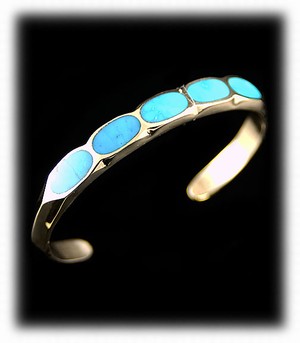 |
Some of the Turquoise from both mines is "gel" quality gem material that is glassy in appearence.
More Nevada Blue Gem Turquoise History, Pictures and Information
|
|
Very little large material ever came out of the Blue Gem Turquoise Mine, the majority found was small 1mm - 4mm "feeder" veins and tiny nuggets which were perfect for Zuni inlay Jewelry and fine needlepoint Turquoise Jewelry, petit-point jewelry and snake-eyes Turquoise jewelry. In general we find most of the really high color turquoise we cut comes from these small veins or if tumbled out they are called waffers. So, it is really probably better that most of the Blue Gem Turquoise sold was this type of material. There's just something about Blue Gem Turquoise. It is a treasure: a rare, valuable and historic American turquoise. When we think of Blue Gem Turquoise, we think of translucence, depth, watery, what we mean by "non-opaque, silicated" jewels. This turquoise is hard and won't change color, takes a high polish and will be beautiful one hundred years from now. The character and beauty of these stones are impossible to fully capture in images, since this turquoise has a unique character that's hard to describe. It is like pools of glassy water captured in solid form. We believe this may be some of the greatest turquoise ever mined and once you own a piece you will be addicted to Blue Gem Turquoise. |
Pieces of the Blue Gem Turquoise story quoted from Sky Stone Trading Co.
Back to the Jewelry Learning Center
Thank you for reading about Blue Gem Turquoise, we hope you have learned alot and have a better understand of Blue Gem Turquoise from America.




